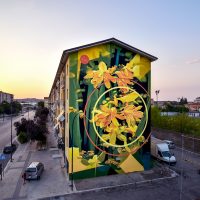Natural fractals Vs urban Euclidean geometry.
As we can see, Fabio Petani’s artistic research becomes, one might say, a means through which plants propagate across the world. Clearly, this does not literally happen via physical colonization of territories, but rather thanks to the knowledge introduced in those parts of the globe where nature has a limited impact on the urban landscape, becoming – as I wrote a few years ago – spagyric remedies for the eyes of the beholder. It is not by chance that, in 2017, journalist and New York Times correspondent Florence Williams, in her book “The Nature Fix: Why Nature Makes Us Happier, Healthier, and More Creative”, by bringing physician Richard Taylor’s theories to attention, demonstrates that science is at the root of nature’s positive effects on our wellbeing, and that contemplation of images depicting natural elements, among which plants, relaxes our brain, specifically because our visual apparatus seems to be structured in order to understand the fractal geometry present within its shapes.
Sadly, most contemporary urban territories are preconceived following narrow designs and structured upon Euclidian lines and shapes, whose rigidity tends to exclude and repel, making its inhabitants unconsciously uncomfortable and disconnecting them from the natural environment.
In this perspective, one of the traits found throughout Fabio Petani’s research within the urban setting lies precisely in the harmony originating from the organic relationship between order and a variety of natural fractal shapes contained in his murals which, contextualized in the urban territory, integrate within it as an element against this tendency. A dynamic element, which overturns the language of classical Euclidean geometry, looking to re-establish a visual balance. Furthermore, after a deeper analysis, his work visually shows us – similarly to the fascinating structure of fractals, which allows compressing large stretches of surface in a minimal space maximizing vital processes – information on the cooperative nature proper of relationships between plant species.
The behavior of Fabio Petani is similar to that of a pollinator insect that dwells in the most diverse urban locations, becoming one of the youngest Italian representatives in the urban art scene. His murals, scattered across Italy and Europe, propagate the knowledge of chemistry and botany in their possible and original alchemical twists, in relation to the history and native elements of those urban environments which accommodate them.
With the awareness that from plants we can learn behaviors that are different and more apt to experience a place to a better degree, each painting by the artist turns into a visual metaphor of the mechanism of permeation, promoting regeneration and a rebirth the sake of change in the way we see the city, to rethink it as an urban jungle whose inhabitants – not only human – transform together with the natural environment.
Alessandra Ioalè
“Strong are the messages of our alchemist Fabio Petani, who mixes chemical and botanical knowledge in an investigating union of the natural essence. Work that winks at the ancient popular wisdom of recognizing plants, but his work is a deeper research, each of his works is a piece of a herbolarium and of the table of elements. Nothing is given to chance, each plant and each element are chemically linked together, this natural and alchemical link between plants and elements develops because everything is linked to the territory in which the intervention is carried out. Fabio leaves scattered throughout the world reflections aimed at respect for nature and every molecule. The alchemical dichotomy of the universe is represented. Everything is represented with strong delicacy, the color palette is almost always soft and gives elegance to his works, and the colors were always chosen to embellish the pages are from his herbarium in the most balanced way possible with the surrounding landscape, so much from a distance his works as one with the previous architecture. To counteract this kindness he contrasts the use of vigorous geometric elements, which break up the linear vision of the whole, the focal point of his works are the phytomorphic figures, which are not banal decorative elements but the botanical heritage of the territory in which they act, these elements floral tend to establish a solid relationship between work and territory. Thus they create the message for those who identify it to regain possession of the natural knowledge of the world, investigating it with a new look, deepening it with the means of science. Because this alchemical combination will bring us back to appreciate what surrounds us and may perhaps be the key to understanding a part of universal functioning.”
Davide Allegretti





